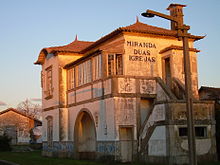Linha do Sabor
| Pocinho – Duas Igrejas | |||||||||||||||||||||||||||||||||||||||||||||||||||||||||||||||||||||||||||||||||||||||||||||||||||||
|---|---|---|---|---|---|---|---|---|---|---|---|---|---|---|---|---|---|---|---|---|---|---|---|---|---|---|---|---|---|---|---|---|---|---|---|---|---|---|---|---|---|---|---|---|---|---|---|---|---|---|---|---|---|---|---|---|---|---|---|---|---|---|---|---|---|---|---|---|---|---|---|---|---|---|---|---|---|---|---|---|---|---|---|---|---|---|---|---|---|---|---|---|---|---|---|---|---|---|---|---|---|
| Route length: | 105.3 km | ||||||||||||||||||||||||||||||||||||||||||||||||||||||||||||||||||||||||||||||||||||||||||||||||||||
| Gauge : | 1000 mm ( meter gauge ) | ||||||||||||||||||||||||||||||||||||||||||||||||||||||||||||||||||||||||||||||||||||||||||||||||||||
|
|||||||||||||||||||||||||||||||||||||||||||||||||||||||||||||||||||||||||||||||||||||||||||||||||||||
The Linha do Sabor was a narrow-gauge railway line in Portugal that ran between the Pocinho stations on the Linha do Douro and Duas Igrejas near Miranda do Douro . It was in operation for fifty years from the time it was fully completed (1938) until it was closed in 1988.
history
Planning and construction
By a resolution of the Portuguese government on July 1, 1903, on behalf of the Minister for Public Works, Conde de Paçô Vieira , planning began for the construction of a connection from the Linha do Douro to the Miranda do Douro district , primarily for its mineral resources (Iron mines around Torre de Moncorvo and marble and alabaster reserves) was known and was so far poorly developed. Cross-border rail transport to the Spanish province of Zamora was also considered. It was also planned to build the Iberian broad-gauge railway line, since in the case of a narrow-gauge railway, complex loading would have been necessary in the Pocinho station .
On November 15, 1903, the state railway company Companhia de Caminhos de Ferro do Estado received the building permit for the line, so that the construction work began. The railway company decided to build the line in meter gauge because the topography was not suitable for a broad gauge line. The Portuguese military also supported this due to the proximity to the border. After numerous discussions between the state railway and various government agencies - compromises were also being made, such as a double-lane line to the mines - the parties involved agreed to create the entire line in narrow gauge. It was then also the transmontan topography that seriously impaired the construction. It took five years just to build the railway bridge over the Douro, so that the first one could be completed in 1909. The first section of the route, between Pocinho and Carviçais, opened on September 17, 1911.
But the route was also not lucky in the further course of construction. The construction work took a total of 34 years, especially the establishment of the republic in 1910 and the First World War that began afterwards impaired the economic situation in Portugal and with it the money for such complex buildings. In addition, the government cut the project in 1928 financial resources amounting to 900,000 Portuguese escudos to use them for the construction of the railway line to Tomar . As a result, the route never reached its actual destination, the district town of Miranda do Douro, but ended 12 kilometers before in Duas Igrejas. The section Carviçais – Lagoaça followed on July 6, 1927, Lagoaça – Mogadouro on June 1, 1930 and the final piece between Mogadouro and Duas Igrejas on May 22, 1938.
Operation and adjustment
The Portuguese government awarded the operation of the line to the Companhia dos Caminhos de Ferro Portugueses on March 27, 1927 , which in turn awarded a sub-concession to the Companhia Nacional de Caminhos de Ferro on March 11, 1928 . With the merger of all Portuguese railway companies to form Caminhos de ferro Portugueses, the latter took over operations on the route. The population was rather skeptical about the railroad, which is particularly evident in an incident on October 7, 1925, in which a train loaded with manure was shot and occupied by Lagoaça.
From 1932 to 1972 the railway was used for postal traffic in the region. Furthermore, the railway line was important for the further transport of goods for the region, among other things oranges, cherries, fertilizer, baked goods and souvenirs of Jesus of Cartolinha were transported.
After fifty years, traffic on the route ended on August 1, 1988 due to austerity measures by the Portuguese government.
The route has now been completely dismantled and converted into a cycle path.
future
There is currently speculation about the reopening of the line between Pocinho and Torre de Moncorvo, as the Rio Tinto company is interested in mining the Minas de Moncorvo. The rest of the route is to be converted into a tourist cycle path ("Ciclovia"). However, there is a risk of collapse at the combined road and railway bridge over the Douro in Pocinho; the bridge is closed to anyone for safety reasons.
literature
- Herbert Stemmler: The narrow-gauge railways in northern Portugal . In: Wolfgang Messerschmidt (Ed.): Locomotive magazine . No. 68 . Franckh'sche Verlagshandlung, W. Keller & Co. , 1974, ISSN 0458-1822 , p. 372-384 .
Individual evidence
- ↑ a b c d e José Ribeiro da Silva and Manuel Ribeiro: Os Comboios em Portugal - I, Terramar Editores, Lisbon, 3rd edition, March 2008, ISBN 978-972-710-410-9 ; Page 135ff.
- ↑ Gazeta dos Caminhos de Ferro (PDF; 13.8 MB), Volume 39, Number 935; December 1, 1926
- ↑ João Paulo Martins et al .: O Caminho de Ferro Revisitado: O Caminho de Ferro em Portugal de 1856 a 1996., Caminhos de Ferro Portugueses, 1996; Page 54
- ^ Francisco José Viegas : Comboios Portugueses: Um Guia Sentimental ., Lisbon, Círculo de Leitores , 1988; Pages 27, 143
- ↑ Ecopista da Linha do Sabor: Ecopista da Linha do Sabor ,
- ↑ Bluff de mil milhões com as minas de Moncorvo , [Billion bluff around the Moncorvo mines], Jornal de Notícias , March 12, 2012
- ↑ O maior investimento estrangeiro de semper em Portugal pode nascer nas minas de Moncorvo , [The largest foreign investment in Portugal could be in the Moncorvo mines], Público , June 2, 2012
- ↑ Mega-investimento nas minas de Torre de Moncorvo , [Mega-investment in the Moncorvo mines], Sol.pt, October 21, 2011
- ↑ Toda a linha do Sabor poderá vir a ter ecopistas e ciclovias , [The entire Sabor railway could be converted into a cycle path], Jornal de Notícias , February 18, 2012
